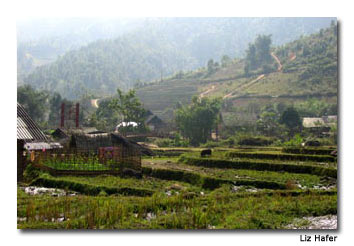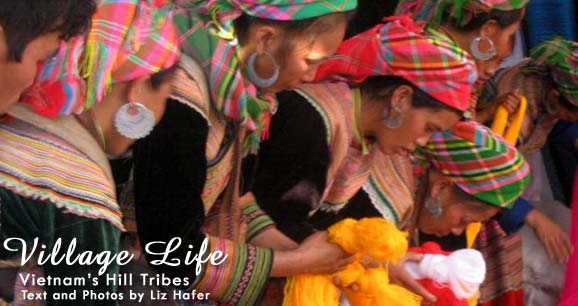
 The gentle rocking of our carriage came to a gradual stop as the long whistle of the train announced our arrival in Lao Cai. Peering out the window of our cozy berth, my traveling partner, Ramona, and I witnessed the deep pink of a dawning sky as the sun rose to burn off the morning mist.
The gentle rocking of our carriage came to a gradual stop as the long whistle of the train announced our arrival in Lao Cai. Peering out the window of our cozy berth, my traveling partner, Ramona, and I witnessed the deep pink of a dawning sky as the sun rose to burn off the morning mist.
We had traveled on the night train to the very northern reaches of Vietnam, home to more than 50 indigenous hill tribes that populate the countryside. This was the beginning of our two-week journey in Vietnam. Our mission was to create an itinerary that captured the heart and soul of the Vietnamese culture for the future clients of our travel company, Soul Adventures.
The bustle and excitement of passengers exiting the train gave way to the rich morning sounds of a village just awakening. Roosters crowed in the distance as locals pushed their wooden carts of wares, and drivers lined the street outside the train station, engaged in friendly banter.

Still chilly from the frosty night, we bundled up and went in search of our driver. We found our guide, Thang, and were welcomed with a big hello and a warm smile as we loaded our gear into the truck for our journey north into the Sapa Valley.
We swayed on the winding road as it led us deeper into the mountains, and the deep green of the rolling hills blanketed our route.
Local hill-tribe women, heavily laden with finely woven baskets on their backs, traveled on foot toward town to trade their goods. As we made our way around the final bend in the road, we spied the bright orange and gold of the Victoria Hotel atop a hillside.
Inside, we were greeted by the crackling of a warm fire and fresh mango juice. Finely carved wooden musical instruments and rich tapestries — crafts made by local villagers — adorned the lobby and guest room walls. This was to be our base camp of adventure for the next four nights.
A cool morning mist blanketed the valley as we ate a hearty breakfast buffet — a combination of Western classics and the robustly spiced foods of Vietnamese cuisine. Steaming hot noodle soup, sushi and fresh breads filled us up as we gazed at the villagers filling the streets of Sapa below.
The town of Sapa is part of a network of small villages that can be reached by a complex array of footpaths. Ramona, Thang and I left our hillside retreat and descended about a half mile on a steep and rocky footpath to the valley floor, which was elegantly carved by the cool, rushing waters of the Muong Hoa River.
Hunched over large boulders at the river’s edge, a woman dressed in the blue denim dress of the Black Hmong tribe scrubbed a pile of clothing in the river as men and women passed on foot bearing heavy loads of rock, wood and bamboo. Crossing the river over a solid foot bridge, we ascended the northern bank and wound our way through seemingly endless rice fields of the many villages dotting the lush landscape.
A handful of houses comprised each village, and as we passed by, children ran from their homes and, with the biggest of smiles, loudly exclaimed “Hello!” A “hello” back always resulted in deep laughter, as they repeated their “hello” in hopes of prolonging the exchange.
The sun was warm on our backs as the winter mist of the valley gave way to a clear blue sky. We walked gingerly, balancing along the slippery mud mounds outlining each rice terrace, careful not to fall into the thick gooey mud of the recently harvested beds.

Traversing the northern slopes of the immense valley, we could see our next destination below, along the swiftly flowing river. Ban Ho village was tucked away in lush tropical vegetation of bamboo and palms. Homes were simple, square or rectangular one-room structures constructed of a mix of strong thatch and wood, stilted to protect farm animals that lived below.
We were entertained by a mama pig wandering, her piglets in tow, below one of these homes. Nearby, a young woman bent over an immense caldron of steaming white rice, preparing the midday meal for the small community of family homes, while the piglets maneuvered their way through the cooking area.
Mid-afternoon, after a leisurely lunch along the banks of the Muong Hoa, we continued our hike. A long, beige, dust-covered concrete building drew us from the winding trail. Deep within its walls, we could faintly hear young voices reciting the ABCs. Thang noted that mastering English is a prized accomplishment for the youth of Vietnam today, as they seek a secure future. Reaching the building, we cautiously peered through one of several open doorways.
Worn wooden desks lined the small room, with two children per desk huddled over books. We counted 10 children who couldn’t be much more than six years of age. A young woman who looked no older than 20 stood in front of the room as the children intently read aloud. We stood quietly in the doorway as we watched.
Then we were discovered. The grins of the children gave way to a round of giggles as they shyly peered up from their books. Without missing a beat, they continued repeating the words of their teacher. “DOG.” “Dog.” “BALL.” “Ball.” A bell rang and their recitation stopped. The children were instantly on their feet, hurriedly making their way outside through open doorways.
It was their midday break, and now the children could follow us, at least for a little way, as we continued on the path to the next village. Hand in hand, the children walked at a safe distance behind us. The giggle of innocent excitement serenaded our journey.
Up ahead a group of women dressed in the bright reds of the Red Zhao village awaited our arrival to display their wares. The most assertive of all the hill-tribe villagers, these women had a mission: To sell us the fruits of their labors. With friendly smiles, the women invited us into their homes to view their crafts.
The dark, wooden huts with dirt floors were simply laid out. A mattress on the floor in one corner, a cooking pit in another, and a sitting area with just enough small wooden chairs for the family was at the center of the home. Here is where the negotiations began.
Brightly woven purses and shawls suddenly appeared. Several of the Red Zhao women begged for our attention. “Good price for you” they said, in English. Asking what that price might be, we learned that $1 US was the special for that day. Banter back and forth, many friendly smiles and an occasional word from Thang helped us to our final negotiation of two beautiful needlepoint purses for $1.
All of us were happy with the exchange. We gathered our things and went on our way. As we looked back along the trail, the village women and children waved at us with big smiles.
Each turn of the trail brought us to yet to another wonder of this region. The spirit of this culture, deep within the valley, touched our hearts. It was only the first day, and our journey had just begun.
If You Go
Vietnam Travel Tips
November through February is the best time to visit Vietnam. The northern cities of Sapa and Hanoi are clear and cool during this time. The central cities of Danang and Hoi An are pleasantly warm, while the southern cities of Saigon and Can Tho are warming up, but are not yet the steamy temperatures of the spring and summer season.
Soul Adventures offers two-week adventure tours for small groups spanning the entire country of Vietnam in December and January, as well as custom tours, upon request. Prices include 4- to 5-star accommodations, all in-country transportation, meals and fees for activities. Pre-and post-trip excursions to Cambodia can also be arranged. Small-group travel and meticulously planned details ensure a quality experience.
Soul Adventures: 303-881-5185
www.souladventures.org
[email protected]
Vietnam National Administration of Tourism: www.vietnamtourism.com
- Life of a Champion: Exploring the Muhammad Ali Center in Louisville - April 19, 2024
- What It’s Like to Live as an Expat: Lake Chapala, Mexico - April 18, 2024
- Top 5 Spots for Stargazing in North Carolina - April 17, 2024

If you want to discover the wild beauty of Vietnam. We are always happy to serve you.
Thanks for your interesting article. This bring a taste of adventure in northern Vietnam.